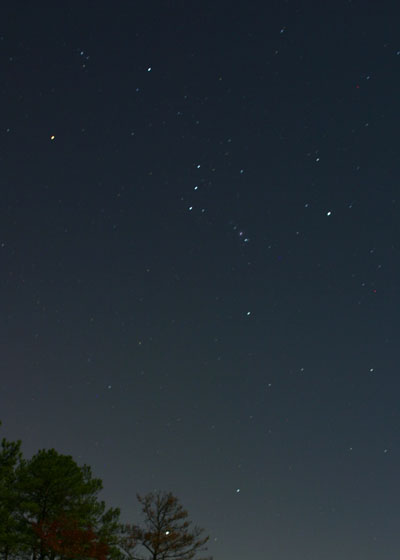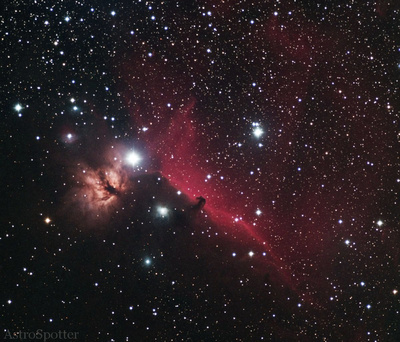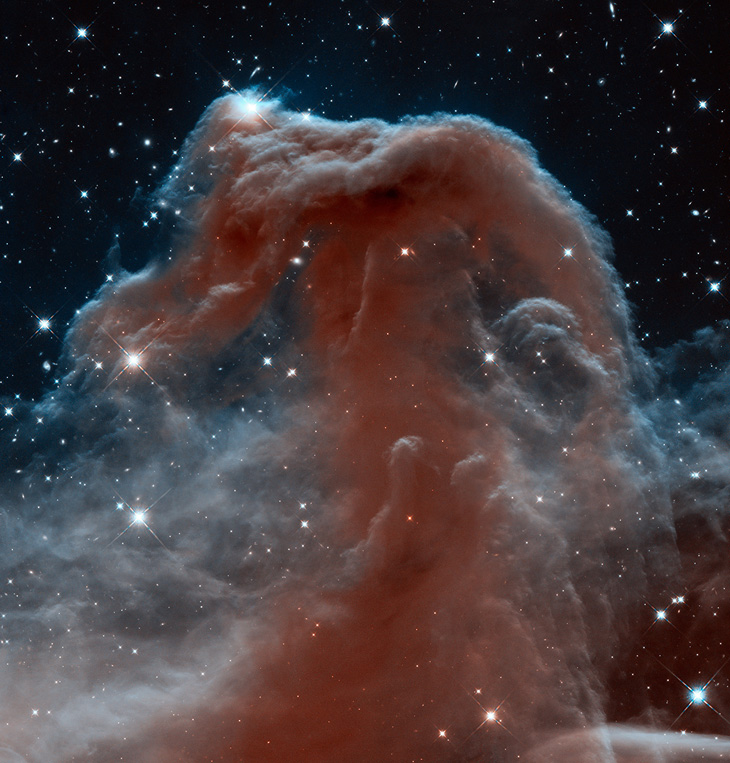Twenty-three years ago today, the Hubble Space Telescope was launched into low-earth orbit (meaning about 555 km, or 345 mi, above the surface of the Earth.) Since that time, it has produced perhaps the largest body of work of any single telescope, and certainly some of the most detailed. And just recently, NASA released a sweetheart.
 Let’s start with some perspective. Everyone (who matters) knows the constellation Orion. Anyone interested in astronomy knows Orion is overflowing with cosmic goodness, aflame with nebulae and gases and new stars and all that jazz. To the naked eye and pretty much any non-telescopic photography attempt, Orion looks like what I’ve captured here: just stars, though a close look at the ‘dagger’ (ahem) gives some indication that they’re fuzzier (ahem) than just orbs (yes, I’m having fun, thanks for asking.) Ford Prefect is from a planet around that yellow star at upper left. Orion’s belt is/are the three stars almost vertical, right in the center of the image, and the dagger is/are the three stars extending diagonally towards the lower right. The dagger is actually a mess of stars and nebula, and in fact, most of the center of Orion is gas and dust and whatnot. The belt stars, however, really are just three stars, as everyone who remembers the dialogue from Men In Black knows. The thing is, to see all the fun stuff in detail requires not just a powerful telescope, but some fancy filters to select specific wavelengths, the emission spectra of hydrogen or oxygen or whatever, and a scope that counteracts the rotation of the Earth because long exposures are needed – the light is far too faint to capture otherwise.
Let’s start with some perspective. Everyone (who matters) knows the constellation Orion. Anyone interested in astronomy knows Orion is overflowing with cosmic goodness, aflame with nebulae and gases and new stars and all that jazz. To the naked eye and pretty much any non-telescopic photography attempt, Orion looks like what I’ve captured here: just stars, though a close look at the ‘dagger’ (ahem) gives some indication that they’re fuzzier (ahem) than just orbs (yes, I’m having fun, thanks for asking.) Ford Prefect is from a planet around that yellow star at upper left. Orion’s belt is/are the three stars almost vertical, right in the center of the image, and the dagger is/are the three stars extending diagonally towards the lower right. The dagger is actually a mess of stars and nebula, and in fact, most of the center of Orion is gas and dust and whatnot. The belt stars, however, really are just three stars, as everyone who remembers the dialogue from Men In Black knows. The thing is, to see all the fun stuff in detail requires not just a powerful telescope, but some fancy filters to select specific wavelengths, the emission spectra of hydrogen or oxygen or whatever, and a scope that counteracts the rotation of the Earth because long exposures are needed – the light is far too faint to capture otherwise.
Most people have also seen photos of the Horsehead Nebula, a dark blob against the red background cloud. Many, however, don’t know where it is. See the lowermost star of the belt (named Alnitak)? To the right, forming a right angle with the beltline, sits another star, Orion’s Cellphone. No, I keed, it’s Sigma Orion (σ Ori) which is actually a cluster of five stars which makes discussing anything of this sort rather tedious but forget all that for now. If you use those two stars (shut up) as the base of a triangle pointing downwards, the tip of the triangle is roughly where the Horsehead Nebula sits.

All that’s just the buildup, like how almost the entire plot of Raising Arizona is presented before someone starts yodeling over the opening credits (yes, I just shamelessly made a comparison between my post and the Coen brothers, but I’ve already been damned to hell long ago.) Now that I’ve discussed how little we can see, check out what Hubble produced by imaging the Horsehead Nebula strictly in infra-red:

Is that as cool as shit or what?
Here’s the deal. The red clouds in most other images of the nebula comes from hydrogen, weak light emitted as it cools, and sits in a pretty specific wavelength of light (mostly around 656nm, known as Hydrogen-alpha.) That light is blocked by the dust of the horsehead, so it appears dark against the red light. This image is taken solely in infra-red, which penetrates the dust much better but is not emitted at all (or very much) by hydrogen, so the background becomes clear while the cloud suddenly gets shape and depth and contours. As can be seen, it still reflects some IR, mostly from a source (almost certainly stars) towards the top of this image. In the previous post I talked about photographing at IR wavelengths from 720 to 950nm; Hubble produced this image with filters for 1,100 and 1,600nm (1.1 and 1.6μm, or micrometers rather than nanometers.)
The crosses over some of the stars in the image are diffraction spikes, an artifact of the Hubble telescope and not something you’d see if you were viewing this ‘up close’ (a few light years away.) Basically, they mean that the secondary mirror of the telescope, which sits in the ‘mouth’ of the tube, is supported by four thin arms; the spikes are from light being redirected by the arms, but the particular details of this will wait for a later post when I know more about how it actually works (it’s one I’ve had on the docket for a while now.) What’s not shown in this image are several young stars further down in the dust cloud. Nebulae such as this are stellar nurseries, loaded with the raw materials for stars and planetary systems, and over time the combined gravity draws clumps together into superdense concentrations, which eventually flare from the heat and pressure into stars. Or the clumps might be less dense and simply become planets, in some cases not aligned to any star but sitting all by themselves, cold and alone and really not very interesting. I mentioned some of the consequences of such nurseries in a previous post.
The image links to the main Hubble site, where you can download numerous versions of it. Definitely check out the largest and zoom in to see it in detail; it’s amazing how many galaxies can be found in the background, including what I believe is gravitational lensing seen at upper left and upper right (the positioning seems too circular to be random.)
Hubble’s significant advantages over Earth-based telescopes are the freedom from the filtering and scattering effects of the atmosphere, and its ability to aim very accurately at any section of sky for long periods – this includes an ability to re-aim, multiple times, and still get useful images. Hubble sits in an equatorial orbit, and with subjects such as Orion that also sit in about that same plane, this means that the Earth will block the shot for a portion of every revolution. The instruments on Hubble include Fine Guidance Sensors that see an arc around the scope’s field-of-view and are used to lock onto specific stars, fixing its orientation during the exposures. The tidal influence of the moon and the sun means Hubble gets tugged gently in other directions, so the detail of these images is testimony to the ability to stay on target. For the Hubble Ultra Deep Field images, this meant exposures totaling about ten days.
I would have liked to have captured an image of Hubble actually passing over on its birthday, but it seems there will be no visible passes for my area on that date, sigh. I don’t have a very good view to the south anyway, which is what is needed for anything in an equatorial orbit seen from my latitude, but I’ll get it one of these days. Feel free to try on your own (it’s listed as “HST” in the Satellite lineup.)




















































